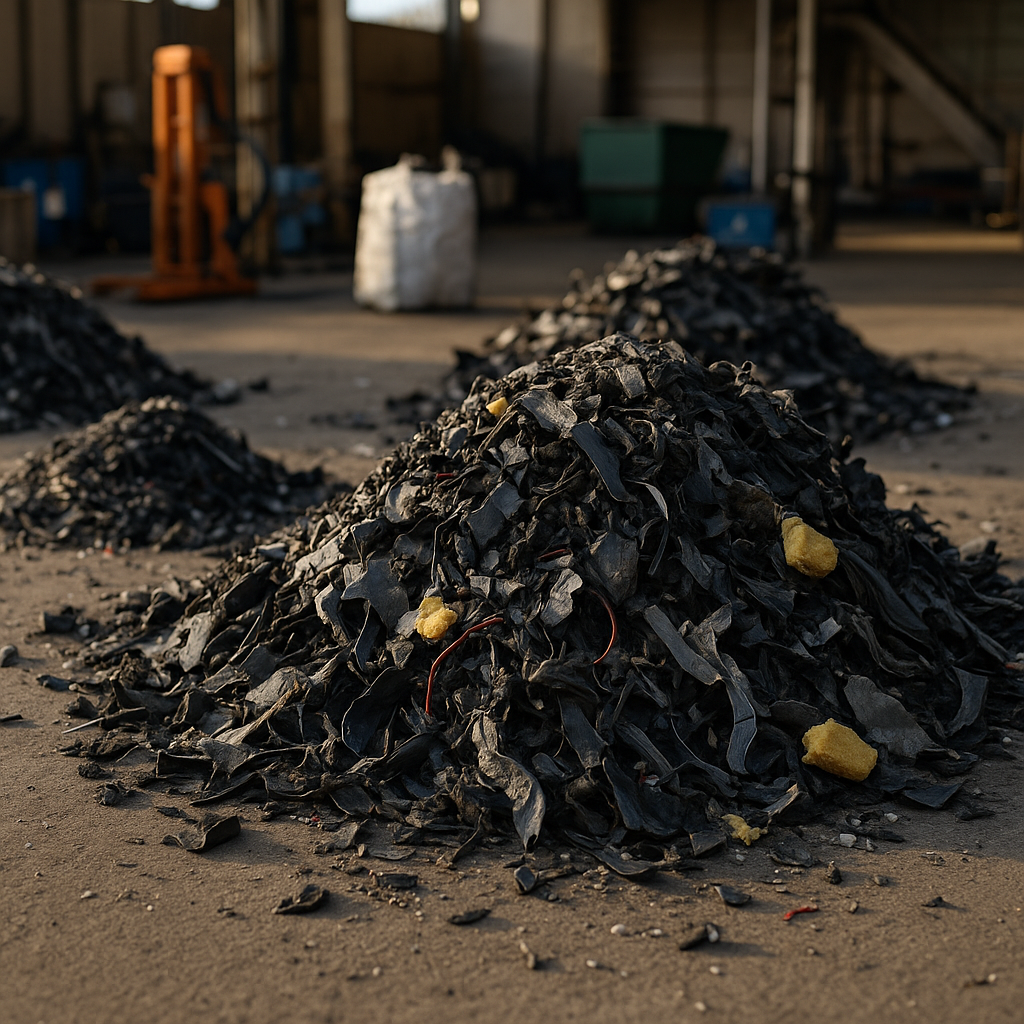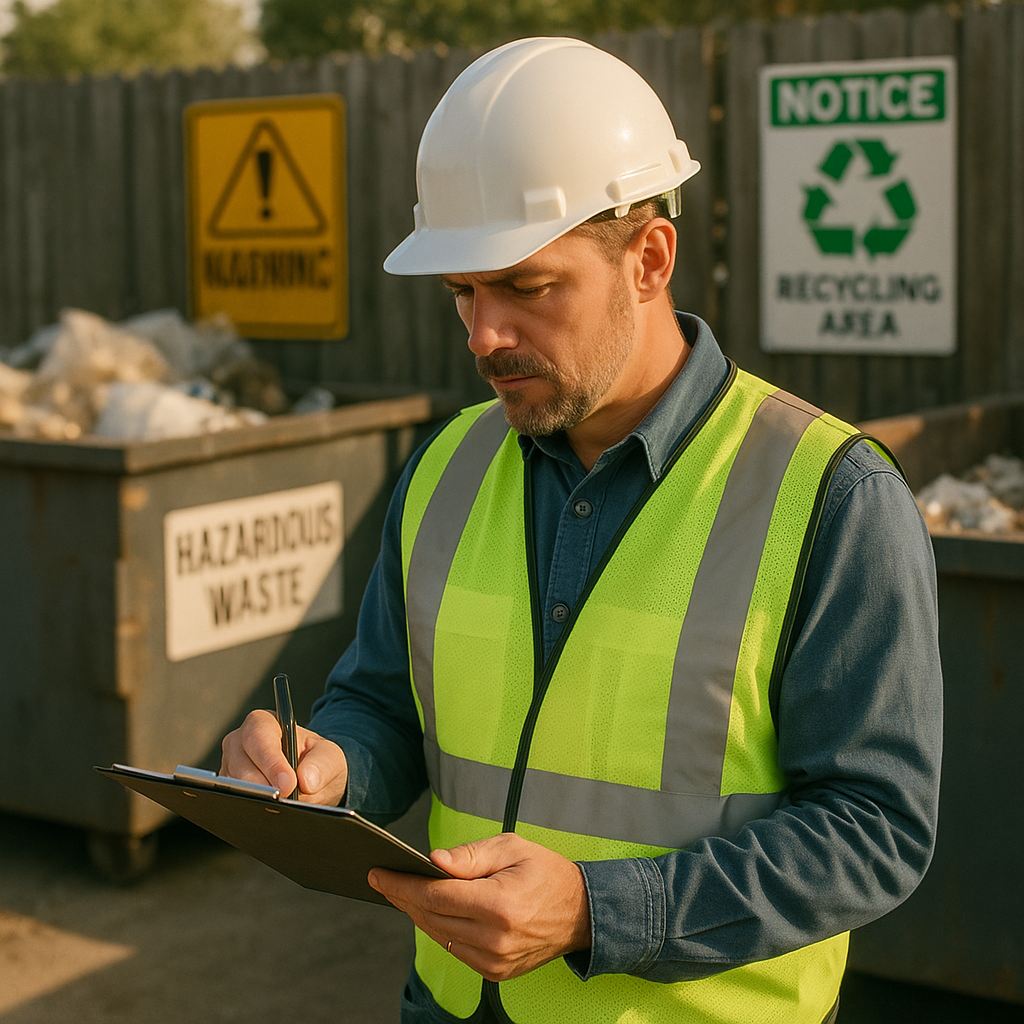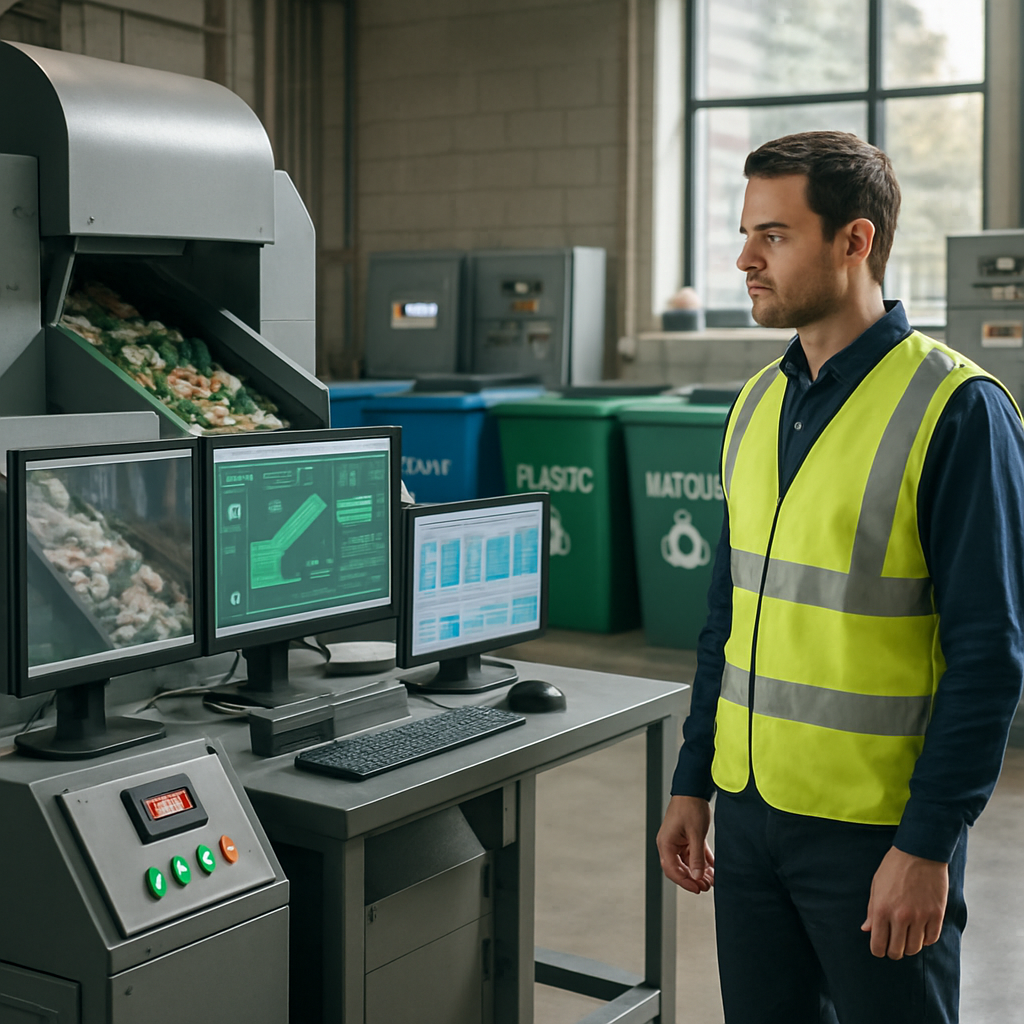5901 Botham Jean Blvd, Dallas, TX 75215
Automotive Shredder Residue (ASR) Processing: Methods, Regulations, and Environmental Impact
October 17, 2025When vehicles reach the end of their useful life, they enter a recycling stream where valuable metals are recovered. What remains after this metal recovery process is known as Automotive Shredder Residue (ASR). This complex waste stream represents 20-25% of a vehicle’s weight and requires specialized processing to minimize environmental impact.
ASR is a heterogeneous mixture containing plastics, rubber, foam, fabric, carpet, glass, and wood. These materials are often contaminated with heavy metals like lead, cadmium, zinc, and copper, along with small amounts of petroleum hydrocarbons and PCBs. Without proper treatment, these contaminants pose significant environmental risks.
The primary goal of ASR processing is to reduce the leaching potential of these heavy metals through chemical stabilization. Treatment typically involves applying silicate-based solutions and alkaline activators that bind metals into insoluble compounds. This important environmental technology transforms potentially hazardous waste into material suitable for disposal or beneficial use as alternative daily cover in landfills.
How is ASR Generated and What are its Components?

ASR (Auto Shredder Residue) is created during the recycling process of end-of-life vehicles (ELVs) and household appliances. When these items reach the end of their useful life, they undergo a multi-stage recycling process. Initially, the materials are placed into a large hammermill shredder that reduces them to smaller, more manageable pieces. Next, powerful electromagnets separate the ferrous metals (primarily steel) from the remaining materials, typically recovering 75-84% of the vehicle’s weight as recyclable metal.
The remaining 16-25% becomes what is known as ASR. This material represents a significant volume, with over 5 million tons produced annually in the U.S. alone. ASR is notably complex and heterogeneous, consisting of various materials including:
- Plastics (approximately 30% by weight)
- Foam (5% by weight but up to 30% by volume)
- Rubber
- Textile and fiber materials
- Glass (2-18%)
- Wood (2-5%)
- Road dirt and debris
- Residual metals not captured in the separation process
The management challenge with ASR lies not just in its mixed composition but also in the presence of hazardous substances. The residue typically contains small amounts of heavy metals such as lead, cadmium, copper, and zinc. Other concerning components include residual petroleum hydrocarbons from lubricating oils and automotive fluids, as well as PCBs (polychlorinated biphenyls). In some cases, the concentrations of these hazardous materials can approach or exceed regulatory thresholds for safe disposal.
ASR’s physical characteristics vary widely, ranging from fine granular particles similar to sand and soil to larger identifiable pieces of carpeting, foam, or plastic, which can exceed 5 inches in cross-section. This range of sizes and material types creates significant challenges for recycling operations attempting to further separate and recover valuable components from the waste stream.
The complex nature of ASR makes it difficult to recycle through conventional methods. While the metals content (which can account for 25-30% of ASR weight) represents a potentially valuable recovery target, the varied and contaminated nature of the material requires specialized processing equipment and techniques. This complexity explains why most ASR has historically been sent to landfills rather than recycled, though environmental regulations and resource conservation efforts are gradually shifting this practice toward more sustainable processing solutions.
What are the Key Steps in ASR Processing?
Auto Shredder Residue (ASR) processing employs chemical stabilization to convert potentially hazardous waste into safe material. This carefully controlled process follows specific steps to bind heavy metals and reduce their leaching potential. Let’s examine how this essential treatment works.
The first step is preparing the soluble silicate solution. Operators create an aqueous mixture using potassium silicate or sodium silicate complexes. These silicates serve as the primary binding agents interacting with metal oxides in the ASR. The solution typically contains 3-20% silicate by weight, with the exact percentage adjusted based on the ASR’s existing moisture content.
Next is the application phase. The silicate mixture is sprayed onto the ASR as it moves along conveyor belts from the metal separation systems. This wetting process ensures the even distribution of the silicate solution throughout the material. The spray rate requires careful calibration to prevent oversaturation while maintaining adequate coverage.
After wetting, the ASR enters a pug mill mixer. This equipment provides the necessary mechanical action to thoroughly mix the silicate solution with the ASR. The material remains in the mixer for a set residence time to allow initial reactions to begin between the silicates and metal particles.
The final chemical addition involves introducing an alkaline activator (AA). Most facilities use Portland cement, though some may employ fly ash, lime, or other pozzolanic materials. The AA creates a high-alkalinity environment that enhances the dissolution reaction of metallic particles in the ASR. Precisely calibrated metering screws introduce the dry AA into the pug mill at rates determined by the weight of ASR on the conveyor belt.
At this stage, the chemical reactions commence. The metals in ASR, typically found in oxide form, react with silicates to produce compounds called metal-silicates. The reactive silicate formulations specifically inhibit the formation of metal hydroxides while promoting stable metal-silicate bonds. This chemical transformation significantly reduces the metals’ ability to leach into the environment.
The entire treatment system requires ongoing monitoring and calibration. Operators must maintain proper silicate-to-water ratios and AA addition rates based on the metal concentration profiles in the incoming ASR. Regular sampling and analysis help facilities adjust these parameters to ensure effective treatment while minimizing chemical usage.
The process achieves significant results, typically reducing the solubility of key heavy metals like lead, cadmium, and zinc by 67-99%. This substantial decrease in leaching potential transforms ASR from a potentially hazardous material into one that can be safely used as alternative daily cover in landfills or disposed of as non-hazardous waste.
Through this carefully engineered sequence of chemical applications and reactions, ASR processing facilities effectively address environmental concerns while supporting responsible management of automotive waste.
| Metal | WET Extractable in Untreated ASR (mg/L) | WET Extractable in Treated ASR (mg/L) | Reduction (%) |
| Cadmium (Cd) | 0.645 | 0.160 | 75% |
| Lead (Pb) | 48.17 | 4.33 | 91% |
| Zinc (Zn) | 1213 | 113 | 91% |
What are the Environmental Concerns and Regulations for ASR?

Auto Shredder Residue (ASR) contains various toxic components that pose significant environmental risks if not properly managed. The complex composition of ASR, which includes plastics, rubber, foam, and cloth contaminated with heavy metals and other harmful substances, creates multiple pathways for environmental contamination.
Environmental agencies have identified several key concerns associated with ASR. Stormwater contamination occurs when rain or facility operations cause water to flow through ASR piles, creating toxic runoff. Air deposition is another significant issue, as fine particulates generated during the shredding process can become airborne and settle on surrounding soil, roofs, and other surfaces. Studies in California indicate that these particulates may pose health risks, especially to respiratory systems. Additionally, contaminants are often tracked off-site when vehicles and equipment move between ASR handling areas and public roads.
ASR classification varies across jurisdictions in terms of regulatory oversight. In some states, untreated ASR is classified as hazardous waste due to its toxic constituents. This classification leads to strict handling, storage, and disposal requirements under both the federal Resource Conservation and Recovery Act (RCRA) and state-specific regulations.
The California Department of Toxic Substances Control (DTSC) plays a leading role in establishing regulatory frameworks for ASR. Under their guidelines, ASR can be reclassified from hazardous to non-hazardous waste only after treatment processes that effectively reduce the mobility and toxicity of its components. These treatments must address specific concerns such as the leachability of heavy metals and other toxic substances.
Regulatory agencies apply various testing methods to determine whether ASR is hazardous. These include the Toxicity Characteristic Leaching Procedure (TCLP) at the federal level and additional tests like the California Waste Extraction Test (WET) and Total Threshold Limit Concentration (TTLC) analyses in some states. ASR often contains levels of lead, cadmium, PCBs, and other substances that exceed regulatory thresholds.
Best management practices for ASR facilities have evolved to address these environmental concerns. These practices include installing wheel wash stations to prevent contaminant tracking, covering ASR piles, implementing vacuum sweeping on and off-site, installing roof drain filter socks, and limiting both the size of ASR piles and the duration they remain on site.
The regulatory landscape for ASR continues to evolve as research provides new insights into its environmental impacts. Current regulatory reviews focus on the long-term effectiveness of ASR processing methods instead of just immediate compliance. This shift reflects a growing understanding that some contaminants in ASR may persist in the environment for extended periods, necessitating management approaches that account for long-term risks.
Conclusion: The Future of ASR Processing and Recycling

ASR processing is at the forefront of sustainable automotive waste management. As vehicles reach the end of their lifespan, properly handling automotive shredder residue becomes crucial for reducing environmental impact. Current methods focus on stabilizing heavy metals to ensure safer disposal, but the industry is set for considerable advancement in the coming years.
The future of ASR processing lies in innovative technologies that can transform this challenging waste stream into valuable resources. Molecular recycling is among the most promising developments, capable of breaking down plastic-rich ASR components at the molecular level. This approach allows materials to be rebuilt into new polymers that perform identically to virgin materials without sacrificing quality or safety.
Collaborative efforts between recyclers, automotive manufacturers, and technology developers will be vital to advance these emerging solutions. Recent feasibility studies show that closed-loop recycling of ASR is not only possible but also commercially viable. These partnerships are creating pathways for materials once destined for landfills to find new life in high-quality automotive applications, supporting a more circular economy for the industry.
For expert guidance on sustainable waste management solutions for your automotive recycling needs, contact Okon Recycling at 214-717-4083.
